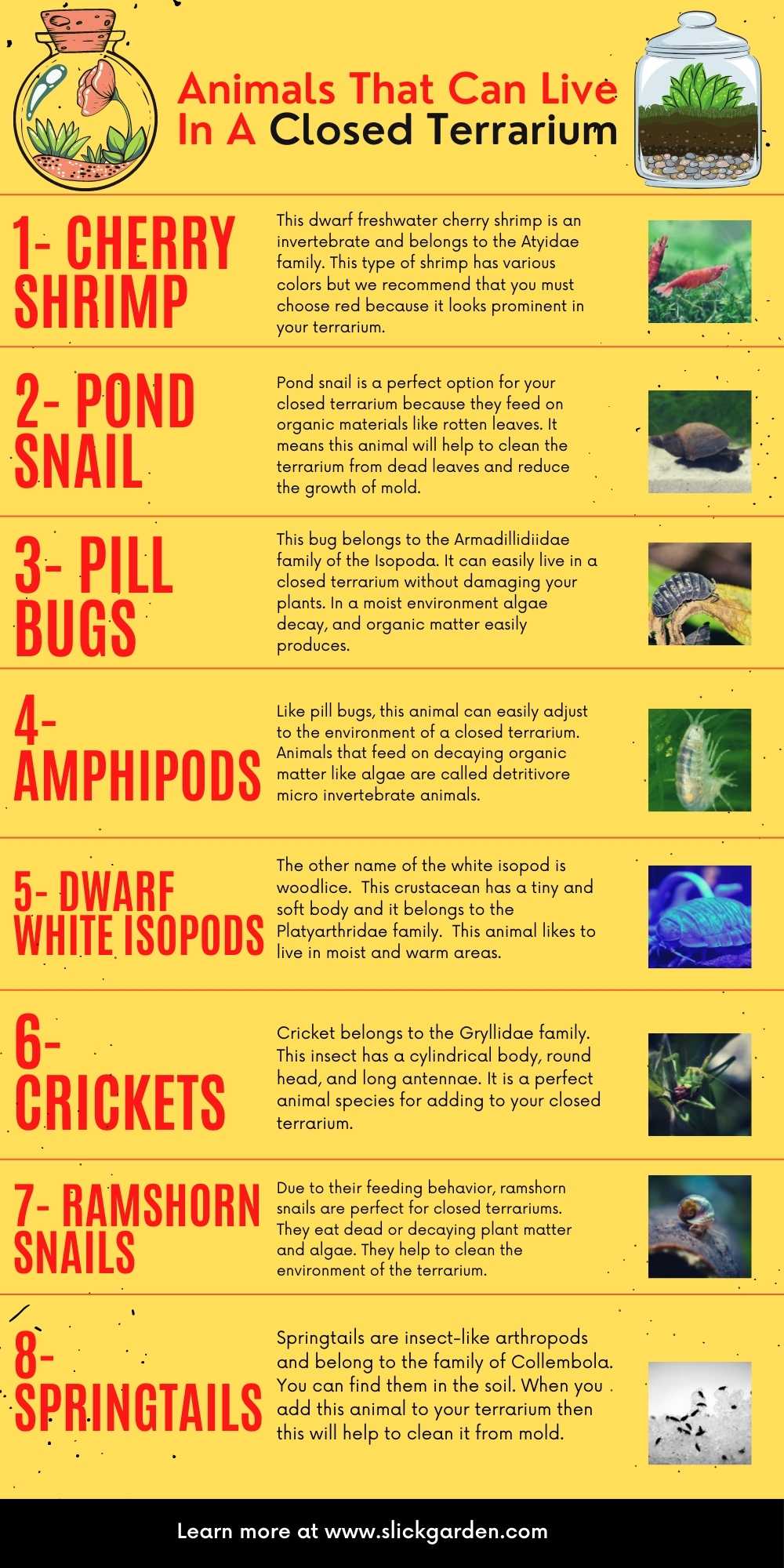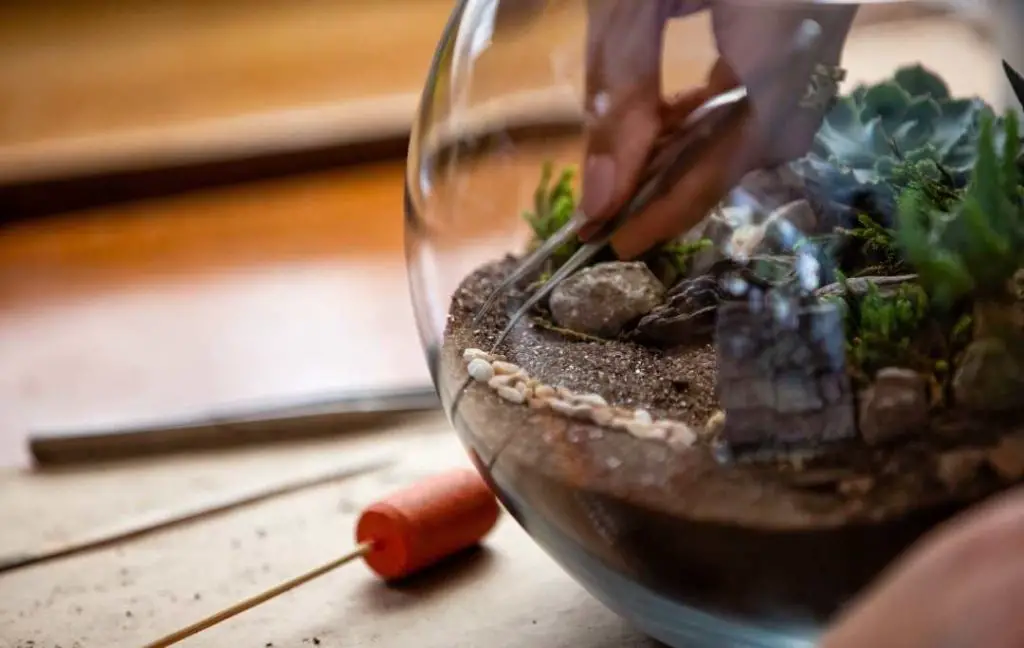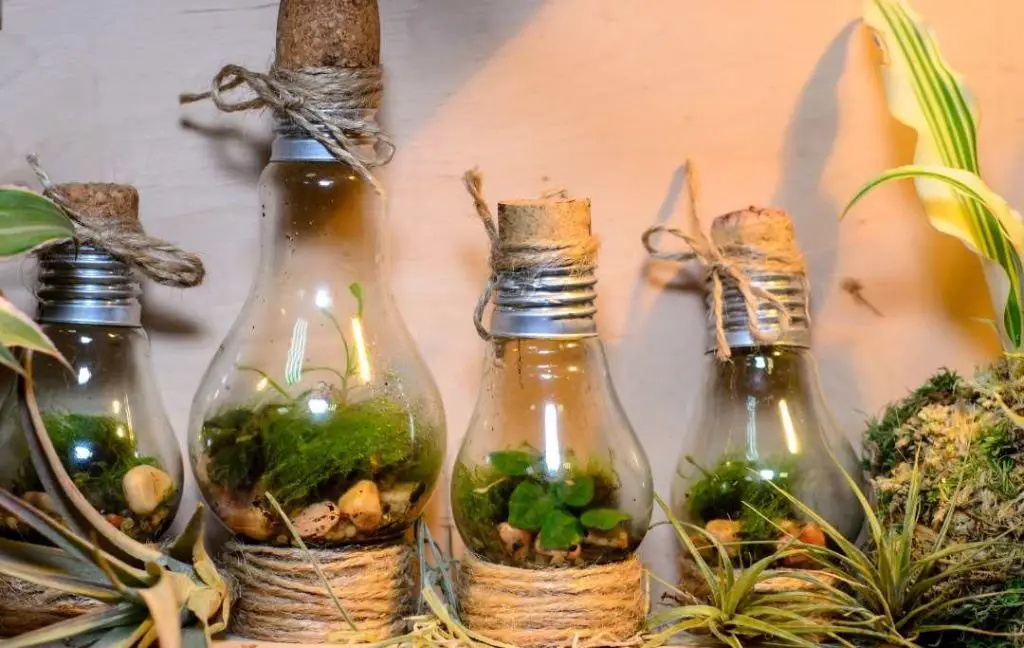Don’t you want to decorate your house with a miniature glass garden? You can add attractive plants and animals to this glass garden. This miniature glass garden is called a terrarium.
It is better to embellish your house naturally. When you bring nature inside your living area it will help to relieve stress. Terrariums don’t need large space and proper maintenance.
There are two types of terrarium: open terrarium and closed terrarium. Open terrariums are designed to provide air to plants and animals. In a closed terrarium, the water cycle is an important factor. Now we will tell you about the closed terrarium in detail.
What Are Closed Terrariums?
A closed terrarium is a glass container with a lid. Some plants and animals give it a natural look. A closed terrarium is a self-sufficient system and depends upon water vapor for an active ecosystem.
You can easily understand the water cycle of a closed terrarium. At high temperatures, the moisture of soil and plants forms water vapors in the glass container.
These vapors again substrate and help plants to survive in the glass jar. You should pick those plants that like to grow in moisture like mosses, ferns, ivy, and fittonia. These plants are ideal for fitting in the environment of a closed terrarium.
Animals That Can Live In A Closed Terrarium

Besides plants, you can also add animal species to your closed terrarium. Now we will discuss with you a list of animals that can easily live in a closed terrarium without any trouble.
Small invertebrates are perfect for living in an environment of a closed terrarium. The reason for adding invertebrates to your terrarium is that vertebrates are not adjusted easily in a sealable environment.
The presence of bioactive tanks is the reason for low bioload capacity which is not good for these animals. As we mentioned above you can add invertebrates but keep in mind not all invertebrates are suitable for this purpose.
Some invertebrates will feed on your moss. The type of animals depends upon the size of the closed glass terrarium you have. Following is a list of those animals that you can add to your small sealable terrariums.
1- CHERRY SHRIMP
This dwarf freshwater cherry shrimp is an invertebrate and belongs to the Atyidae family. This type of shrimp has various colors but we recommend that you must choose red because it looks prominent in your terrarium.
Cherry shrimp in your closed terrarium can get their food from organic matter such as algae and decaying vegetable matter. But you should be careful because they can ruin your moss if they have a shortage of food.
2- POND SNAIL
Pond snail is a perfect option for your closed terrarium because they feed on organic materials like rotten leaves. It means this animal will help to clean the terrarium from dead leaves and reduce the growth of mold.
Your bioactive terrarium will become a perfect place for your plants in the presence of pond snails.
3- PILL BUGS
This bug belongs to the Armadillidiidae family of the Isopoda. It can easily live in a closed terrarium without damaging your plants. In a moist environment algae decay, and organic matter easily produces.
The good thing is that pill bugs like to eat such things so they can easily adjust in your terrarium. But in some circumstances, they start eating moss if they run out of food. In that case, you have to add apple slices and fish flags so they will not eat the moss.
4- AMPHIPODS
Like pill bugs, this animal can easily adjust to the environment of a closed terrarium. Animals that feed on decaying organic matter like algae are called detritivore micro invertebrate animals.
But they start eating plants if there is insufficient food in the closed terrarium for them.
5- DWARF WHITE ISOPODS
The other name of the white isopod is woodlice. This crustacean has a tiny and soft body and it belongs to the Platyarthridae family. This animal likes to live in moist and warm areas.
It means a closed terrarium is a perfect place for them. The perfect humidity level should be 80 to 90 % and the ideal temperature between 72 to 86 degrees Fahrenheit for raising white isopods.
Closed terrariums provide a perfect environment for this animal with decaying plant matter and rotting wood for their feed. They don’t like to eat fungi.
6- CRICKETS
Cricket belongs to the Gryllidae family. This insect has a cylindrical body, round head, and long antennae. It is a perfect animal species for adding to your closed terrarium.
This tiny insect feeds on decaying organic matter so you should not worry about its food. But you should keep an eye on the availability of food. If they run out of food they start eating the plants in the terrarium.
7- RAMSHORN SNAILS
Due to their feeding behavior, ramshorn snails are perfect for closed terrariums. They eat dead or decaying plant matter and algae. They help to clean the environment of the terrarium. Your glass garden will become mold free in the presence of mold.
8- SPRINGTAILS
Springtails are insect-like arthropods and belong to the family of Collembola. You can find them in the soil. When you add this animal to your terrarium then this will help to clean it from mold.
They are also called detritivores because they eat dead organic matter, dead leaves, roots, and rotten wood. As you know they like to live in the soil so it is possible that springtails can damage your plants in the terrarium.
In your sealable glass terrarium, they will not affect moss because most don’t have roots.
Purchase Best Glass Terrariums On Amazon
How To Make A Closed Terrarium With Animals?

Now we will tell you how to create a stunning and attractive closed terrarium with bugs. You can catch these bugs easily. For making a closed terrarium you need a small glass container and apply a layer of sand and soil to it.
You can catch bugs according to your choice and add them to your glass garden to make it more natural. You should maintain the environment of your glass garden by periodic cleaning, providing food, and retaining moisture levels.
Following are the simple steps for creating a beautiful closed glass terrarium for decorating your living area.
STEP 1: MATERIALS YOU NEED FOR MAKING A CLOSED TERRARIUM
- A glass container or jar
- Sand
- Gravel
- Charcoal
- Potting mix
- Pill bugs, beetles, snails, crickets, ladybugs, and other animals according to the size of your terrarium. Never choose poisonous insects such as centipedes, spiders, carpenter ants, and fire ants.
- For decorating your closed terrarium you can use pieces of bark, small branches, and beautiful rocks. Avoid filling your area too much with decoration items. Bugs need to climb and hide so leave most of the space.
STEP 2: GET THE RIGHT SIZE OF GLASS CONTAINER
As we are making a closed terrarium so you should use a container that has a lid. You can also use a mason jar or a fish bowl. The size of the terrarium is according to the size of the insects you are going to add to it.
If you have a regular size container then you can add multiple small insects to it. For larger insects, the space should be doubled so they can get enough room to run and hide.
STEP 3: COVER THE BOTTOM OF THE CONTAINER WITH SAND OR GRAVEL
As you know drainage is very important for the healthy growth of your plants. In a glass container, there are no drainage holes then you have to add such material that helps to drain excess water from the soil.
If you don’t add drainage materials to your sealable glass container then your plant will die of root rot and fungal diseases. You can apply a layer of gravel or sand at the bottom of the glass container. These substances help to improve drainage and maintain the moisture level in the soil.
After the layer of gravel, you can add a thin layer of activated charcoal. You can buy charcoal from any pet supply store. The charcoal will separate the layer of gravel from the soil. It also helps to reduce the smell in the closed terrarium.
STEP 4: FILL CLOSED TERRARIUM WITH SOIL
After applying the layer of gravel and charcoal now is the time for adding soil to your terrarium for your plants. For a plant terrarium, we don’t use garden soil because it is very compact.
It is better to use a potting mix according to the needs of the plants you added to the terrarium. Soil is the medium that provides all the essential nutrients to your plants. It is better to use a high-quality potting mix that has organic material according to the requirement.
But as you are making this terrarium not only for plants but for animals too. In such conditions, you can use outdoor soil because bugs can easily adjust to garden soil. The potting mix you buy from any gardening store must have chemicals that are not good for some critters.
STEP 5: ADDING PLANTS
Plants will make your terrarium more natural. People like to add succulent cacti plants in their terrarium but you can also add weeds in closed terrariums.
You must just go outside and dig up some weeds from the soil. Dig a hole in the terrarium to set plants in the terrarium.
STEP 6: DECORATE YOUR CLOSED TERRARIUM
You can make your terrarium more attractive by adding different decorative items to it. For decorating your close terrarium, you can add colorful rocks, small branches, and pieces of bark.
Bugs in the close terrarium-like hiding spots. When you add these items then they will be happy. But never add too many decorative items because bugs will not get enough space for hiding and climbing.
STEP 7: ADD SOME CRITTERS
You can easily find some bugs in your yard. You can find pill bugs, beetles, snails, crickets, and ladybugs. Don’t add poisonous insects like centipedes, spiders, large black ants, and fire ants.
They hide under branches, flower pots, and rocks. Make sure there must be enough space for your bags to move around in your closed terrarium.
STEP 8: FEED THE NEW RESIDENTS
Most animals that can live in a closed terrarium eat dead organic matter, dead leaves, and roots. But in case they don’t have enough food they start eating your plants.
In such a situation, you can add small slices of vegetables and fruits. For instance, bugs and snails like to eat flakes of carrots, and fish. You can also eat banana peel and actions so the worms easily get their food.
Purchase Best Glass Terrariums On Amazon
How To Maintain Your Terrarium?

Now your terrarium is ready, the next step is maintaining it. Otherwise, your plants and animals in the closed terrarium will die soon.
A CLOSED TERRARIUM IS PERFECT FOR CRITTERS
Never try to place animals in an open terrarium because your bugs will escape from it. If your terrarium is not covered then critters such as snails can climb easily from the terrarium.
Make sure your terrarium is sealable and there is no chance of escaping insects from it. If you are using a mason jar then you can make 5 or 6 small holes in the lid with the help of a hammer and nail. These are air holes that help critters to breathe.
KEEP THE SOIL DAMP
Bugs like to live in a damp environment, it is better to keep an eye on the area for dampness. A spray bottle is perfect to make the soil moist. Your closed terrarium needs little water so avoid watering otherwise the soil will be soaked. The moisture of the soil is important for the critters to dig in it.
The other way of maintaining the humidity level in the terrarium is by placing a dampened paper towel or cotton ball. For checking humidity in your closed terrarium you can use a hygrometer.
The humidity must be above 75%. A hygrometer is easily available from any pet store.
CHOOSE A SAFE LOCATION FOR YOUR CLOSED TERRARIUM
Keep your terrarium in such a place where kids and pets can’t touch it. A high flat surface is perfect for a closed terrarium as they get direct sunlight.
REMOVE UNEATEN FOOD
The small pieces of fruits and vegetables that you add to the terrarium should not be left for decay. Because they will become stinky and moldy.
You should keep an eye on these materials and if you see they are in bad condition then throw them at once. After throwing this stale food, add the fresh one.
REPLACE THE SOIL
If you have small bugs in your terrarium then you can leave the soil for a long time without worrying about bad smells or mold. When you see the soil is in a bad position then change the soil so your bugs will be safe from mold and droppings.
Before replacing the soil you should catch the bugs first and then start cleaning. For large terrariums, you have to clean it every week.
Purchase Best Glass Terrariums On Amazon
